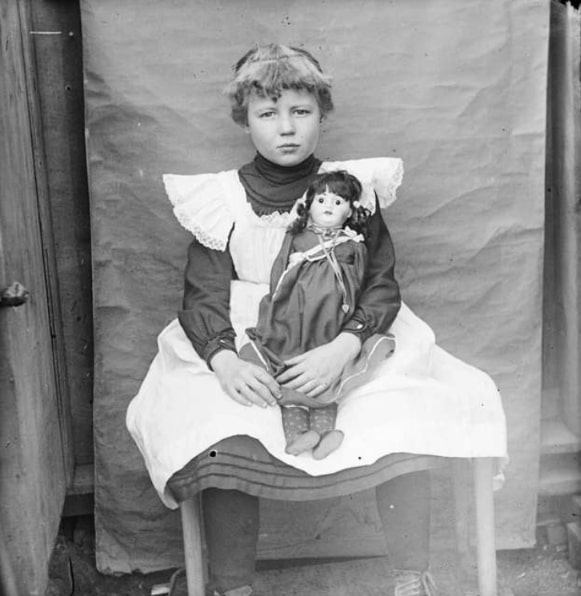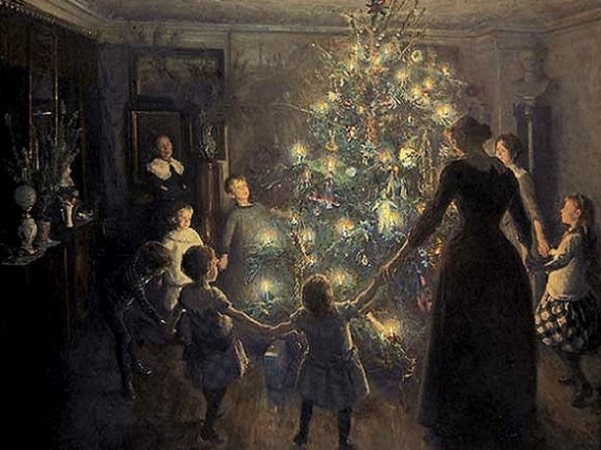Introduction: In this article, Jessica Edwards writes about her mother’s descriptions of celebrating Christmas when she was a child, which shows how much the family holiday celebrations have changed. Jessica has had a lifelong interest in her family’s history – especially on her father’s side, which goes back to the first settlers in Pennsylvania, Jamestown, and New England – and has documented and added more than 37,000 people to her family tree!
Holidays – you either hate them or love them (or, at least, tolerate them). How you feel about holidays usually depends on what past experiences you’ve had and (in my experience) if you live in a family that has small children
Holidays are celebrated in a variety of ways with different cultures celebrating the same holiday in sometimes far different ways. These celebrations can show the past, the present, and the future. They may show how your ancestors celebrated, in almost exactly the same way as it was done in their time. Or perhaps someone may have taken that celebration and altered it so that it reflects the change that has gone on over the years in either themselves or in the country. Still others may want to completely distance themselves from the way their ancestors celebrated the holiday.

I was lucky to get a glimpse into the past when my mother wrote an autobiography that detailed her life up to that point. She left her autobiography to me when she died. In part, she wanted to describe what her life was like during each of the holidays her family celebrated (her father had come from Czechoslovakia and her mother’s parents had come to this country from an area that at times was part of Austria and other times was part of Hungary).
My mother, Carolina, was born in 1937 in Endicott, New York, after her parents had moved there from a small coal mining town in central Pennsylvania. When they got to Endicott my grandfather became a tanner of leather for Endicott-Johnson Show Factory (a big company that employed hundreds of people) full time, and did carpentry part time. My grandmother was a wife and mother until her children were old enough to be on their own, and then she too went to work for E-J (as it was known) sewing shoes. My grandparents had seven living children by 1937 and my mother was the youngest.
The first holiday she describes happened when she was either 3 or 4 years old:
“I remember receiving a 25-cent piece [for Christmas] from my baptismal godfather, Adam Hess. Was laying on the couch playing with it. Well, I swallowed it. It was good that it was stuck in my throat straight up and down – that it didn’t lay down (it would have cut off my breathing, I found out later). Anyway, went into the hospital Christmas Eve & they took it out, but they kept me in overnite for observation. For Christmas (in the hospital) I received an orange, a green paper Christmas tree (about 5” tall) and my quarter back. The doctor gave me another quarter for being so good.”
This description of Christmas Eve/Christmas Day was far different from how the holiday was treated a few years later:
“Our Christmas Day was a religious one. We opened our gifts on Christmas Eve and we usually knew what we were getting: clothes. Never toys. Daddy would give us each a 50-cent piece. Mama got us the clothes. But we did get to eat the popcorn balls on the tree and any cookies. We really didn’t know anyone else’s Christmas was different. Most of our friends were like us: they got clothes. Once in a while they would get a wagon (we all took rides in it) or a bike (we all tried to ride it) or a ball and glove (we all played with them). I never rode a two-wheeler until I was 15. We had passed-down roller skates (had no shoes – just metal [frames that] fitted on the bottom of our shoes) and we tightened them with a key. In the winter we had ice skates that were given to us used.”
Some things stayed the same in their Christmas celebration, but other things were added as the family’s income increased a little. Their celebration of Christmas was far different from my own past as a child, and more different the older I got.
When I was about 5 or 6 years old a big deal happened in about September when the mailman brought the catalogues from Sears and J.C. Penny. It gave us (then it was just my younger brother, Bryan, and me) dreams and hopes of “what Santa would bring.” My mother sat us down in early October each night and we would go through each page with her and discuss each toy that caught our eye, and she would have us pick one or two toys from different categories. She would dutifully write them down “so we could send them to Santa.” (For example, after looking at all of the dolls she wrote down my top two choices.)
Later, we made out our own lists after we developed writing skills. This differed from before, though. When my mother wrote our lists it was done just once. However, when we did our own lists the items could change from day to day, week to week, and month to month.
Another change as we children got older (my sister, Renee, joined us in 1968): our lists would only be partly from the catalogues, because by then commercials had started focusing more on “selling to kids” – which meant they might feature some new toy that wasn’t in the catalogues that year, or started to include things like records and other “more grown-up stuff.” Another change: my lists had a lot of clothes by the time I was 13 or 14.
When my grandparents found out my mother had started making these lists of toys for Christmas, they were horrified. They said my parents were spoiling us – we should just accept what we got and be happy about it. They wanted it to be like when my mother was young. They strongly felt that Christmas should focus more on the religious part of the day and not the presents.
Explore over 330 years of newspapers and historical records in GenealogyBank. Discover your family story! Start a 7-Day Free Trial
Note on the header image: “Happy Christmas” by Johansen Viggo, 1891. Credit: Wikimedia Commons.
To be continued…
